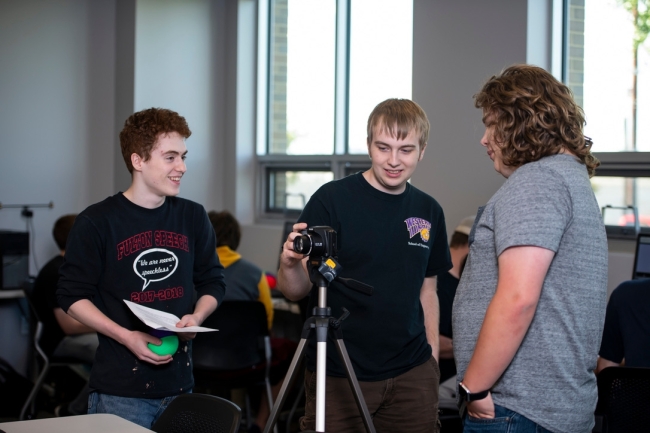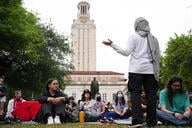You have /5 articles left.
Sign up for a free account or log in.

Caleb Engebrecht (center) served as a learning assistant for a Western Illinois University physics course at the Quad Cities campus. For three years, Engebrecht helped lower-level students in physics and calculus courses in the LA role.
Western Illinois University
Peer support can be a critical service to struggling students. The learning assistant program at Western Illinois University creates an active learning environment in introductory STEM courses, promoting better pedagogy in the classroom and connecting students with older learners who can give guidance and encouragement in the learning process.
This fall, WIU will grow its program, adding learning assistants to chemistry courses in addition to math, engineering and physics courses, and support nearby Black Hawk Community College in kicking off its first LAP.
The background: WIU launched the learning assistant program (LAP) in 2017 as a pilot among first-year physics and math courses. Jim Radchuck, former assistant dean of the WIU College of Arts and Sciences and physics professor, and mathematics professor Susie Brooks implemented LAP at the university.
LAP has three goals: create an active learning classroom environment, encourage mindfulness in learning among faculty and students, and help students succeed in challenging courses.
The program model is based off the University of Colorado, Boulder’s learning assistant initiative, which had over 120 courses and over 360 LAs involved during the 2022–23 academic year.
WIU has two campuses, the primary in Macomb and a smaller branch in Moline called the Quad Cities. Across both campuses, LAs assist in physics, mathematics and engineering courses, with around eight to 10 LAs per term.
How it works: To be eligible as program assistants, interested undergraduate students must successfully complete the course in question and be available to attend all class sessions.
Brooks also says she considers the personalities of students when employing LAs, looking for a mix of introverted and extroverted attitudes to ensure the team’s members can connect with all learners in the course. She looks for students who demonstrate patience, communication skills and the ability to teach in ways other than their own learning style, as well.
During class periods, LAs facilitate active learning activities among students. In calculus courses, for example, LAs can ask open-ended questions to prompt students toward the correct thinking or away from misconceptions, Brooks says.
Outside of the class, LAs enroll in a one-credit pedagogy course, The Science of Learning, and they meet weekly with the course instructor or fellow LAs to discuss their work, which differentiates them from teaching assistants or tutors.
Open to LAs, tutors and lab assistants, the pedagogy course teaches student instructors to connect experiences from their courses to theory with weekly reflections. Students also complete various projects, like writing a learner questionnaire, developing a mini lesson and creating a presentation for the undergraduate student research conference.
LAs also receive an hourly wage and scholarship funds to cover the one-credit course’s tuition.
The impact: At the institutional level, LAP has contributed to first-to-second-year retention trends among engineering students, Brooks says.
LAs also take their learned experiences and apply them outside the classroom. It’s not uncommon for LAs to assist students in their free time on campus or set up one-on-one meetings to review concepts. Assistants also work in their own upper-level courses, Brooks says, helping their peers or applying pedagogical ideas to their homework and learning styles. “They tend to rise above their peers in that they served in this position and they feel comfortable enough to be leaders in some sense.”
As a faculty member, Brooks has found the LAs push her to think critically about course content, delivery and engaging with students. “I am thinking more frequently about my pedagogy and how I can help at-risk students—what can I do to make sure that they don’t slip through the cracks?” she says.
The LAs also contribute to a community atmosphere on campus, Brooks says. The Quad Cities campus is a commuter campus, meaning engaging students can be more challenging compared to a residential setting. But “the learning assistants are familiar faces to these new freshman students, and so if they see a learning assistant in the quad playing Frisbee, they’re more likely to join in,” Brooks says.
The next phase: Starting this fall, WIU will expand the program to include additional calculus and chemistry courses on the Macomb campus.
In addition, a new grant from the National Science Foundation’s Robert Noyce Teacher Scholarship Program allowed WIU to partner with Black Hawk Community College in Moline, Ill., to create an LA program for chemistry, biology, physics and calculus courses.
The grant also designates fellowships, including full-ride scholarships, for around 24 junior and senior students at WIU who want to teach STEM subjects after graduation. The two institutions hope LAP serves as a recruitment tool for identifying fellows and promoting transfers from Black Hawk.
If your student success program has a unique feature or twist, we’d like to know about it. Click here to submit.




